少儿英语DEMO课教案(1)
- 格式:doc
- 大小:66.00 KB
- 文档页数:3
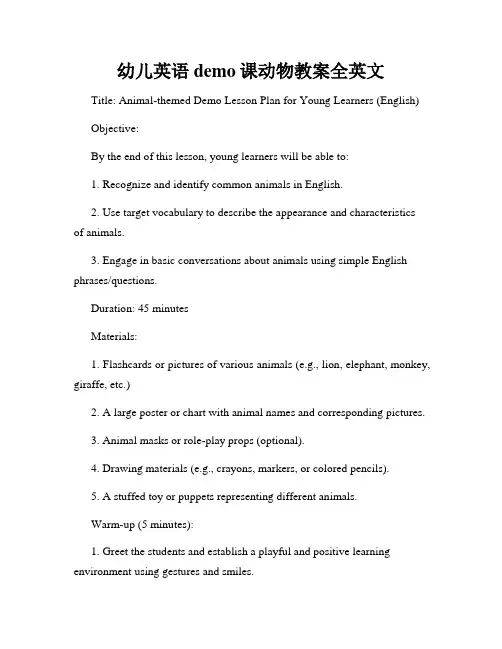
幼儿英语demo课动物教案全英文Title: Animal-themed Demo Lesson Plan for Young Learners (English)Objective:By the end of this lesson, young learners will be able to:1. Recognize and identify common animals in English.2. Use target vocabulary to describe the appearance and characteristicsof animals.3. Engage in basic conversations about animals using simple English phrases/questions.Duration: 45 minutesMaterials:1. Flashcards or pictures of various animals (e.g., lion, elephant, monkey, giraffe, etc.)2. A large poster or chart with animal names and corresponding pictures.3. Animal masks or role-play props (optional).4. Drawing materials (e.g., crayons, markers, or colored pencils).5. A stuffed toy or puppets representing different animals.Warm-up (5 minutes):1. Greet the students and establish a playful and positive learning environment using gestures and smiles.2. Sing a popular children's song about animals, such as "Old MacDonald Had a Farm," to pre-introduce the topic. Encourage the children to sing along and make animal sounds.Introduction (10 minutes):1. Present the flashcards/pictures of different animals.2. Elicit the names of the animals from the students and repeat the words together.3. Use the poster or chart to show the names of each animal, pointing to the corresponding picture as you say the word.4. Distribute animal masks or props for the students to wear or hold, creating a fun and engaging atmosphere.Vocabulary and Language Practice (15 minutes):1. Hold up one of the flashcards or pictures and ask the students, "What animal is this?"2. Once they respond, provide the correct answer and model the pronunciation.3. Show the picture to the class again and ask questions like, "What sound does it make?" or "What color is it?"4. Encourage the students to repeat the questions and answers, both individually and as a group.5. Use the stuffed toy or puppets to act out a brief conversation between animals, modeling simple English phrases and questions for the students to imitate.Activity (15 minutes):1. Divide the students into pairs or small groups.2. Distribute drawing materials and assign each group an animal.3. Instruct the students to take turns describing and drawing their assigned animal, using the target vocabulary and phrases they have learned.4. Circulate among the groups, offering assistance and feedback as needed.5. After a designated time, invite each group to present their drawings and descriptions to the class.Closure (5 minutes):1. Review the names of the animals, using the flashcards or pictures.2. Encourage the students to recap what they have learned about their assigned animal during the activity.3. Sing the animal song from the warm-up activity again, allowing the students to actively participate and demonstrate their knowledge.Extension Activity (optional):1. Provide coloring worksheets with different animal images.2. Instruct the students to color the animals and label them with the corresponding name in English.3. Display the completed worksheets on the classroom walls for further reinforcement and visual reference.Notes:- Adapt the level of difficulty and complexity based on the age and language proficiency of the students.- Use gestures, visuals, and actions to support comprehension throughout the lesson.- Encourage active participation from all students by incorporating opportunities for speaking, listening, and creative expression.- Provide continuous positive reinforcement and create an inclusive and supportive learning environment.。


少儿英语示范课demo课(最新版)目录1.少儿英语示范课的重要性2.少儿英语示范课的内容3.少儿英语示范课的实际应用4.少儿英语示范课的优点5.少儿英语示范课的局限性正文随着全球化的不断推进,英语作为国际通用语言的地位越来越重要。
在我国,英语教育已经从娃娃抓起,少儿英语教育成为了一个热门话题。
其中,少儿英语示范课 demo 课在少儿英语教育中扮演着重要的角色。
少儿英语示范课,顾名思义,就是为少儿提供的英语教学示范课程。
这类课程的主要目的是通过生动有趣的方式,引导少儿学习英语,激发他们的学习兴趣,培养他们的学习习惯。
在少儿英语示范课中,通常会包括单词、短语、句子、语法、听力、口语、阅读和写作等多个方面的内容,从而全方位地提升少儿的英语能力。
在实际应用中,少儿英语示范课通常以 demo 课的形式存在。
这种形式的课程可以让学生和家长在短时间内直观地了解教师的教学方式和教学效果,从而更好地选择适合孩子的英语课程。
同时,少儿英语示范课也可以作为正式课程的辅助教学手段,帮助学生巩固所学知识,提高学习效果。
少儿英语示范课的优点在于其生动有趣、互动性强,能够充分激发少儿的学习兴趣和积极性。
通过这种课程,少儿可以在轻松愉快的氛围中学习英语,提高自己的语言能力。
同时,少儿英语示范课还可以培养少儿的团队协作能力和交流能力,为他们的未来发展打下坚实的基础。
然而,少儿英语示范课也存在一些局限性。
首先,由于课程时间的限制,少儿英语示范课往往无法深入讲解英语知识,只能提供一个大致的了解。
其次,少儿英语示范课的效果受到教师素质的影响较大,如果教师的教学水平不高,可能会影响学生的学习效果。
总的来说,少儿英语示范课在少儿英语教育中扮演着重要的角色。
它以其生动有趣的形式,激发了少儿的学习兴趣,提高了他们的学习效果。
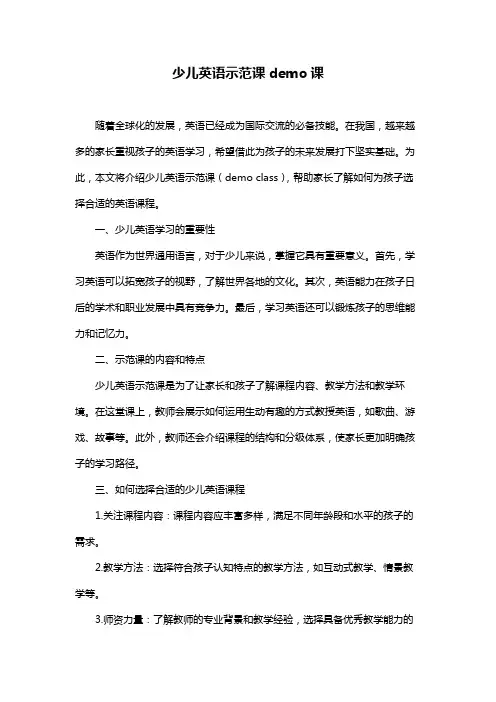
少儿英语示范课demo课随着全球化的发展,英语已经成为国际交流的必备技能。
在我国,越来越多的家长重视孩子的英语学习,希望借此为孩子的未来发展打下坚实基础。
为此,本文将介绍少儿英语示范课(demo class),帮助家长了解如何为孩子选择合适的英语课程。
一、少儿英语学习的重要性英语作为世界通用语言,对于少儿来说,掌握它具有重要意义。
首先,学习英语可以拓宽孩子的视野,了解世界各地的文化。
其次,英语能力在孩子日后的学术和职业发展中具有竞争力。
最后,学习英语还可以锻炼孩子的思维能力和记忆力。
二、示范课的内容和特点少儿英语示范课是为了让家长和孩子了解课程内容、教学方法和教学环境。
在这堂课上,教师会展示如何运用生动有趣的方式教授英语,如歌曲、游戏、故事等。
此外,教师还会介绍课程的结构和分级体系,使家长更加明确孩子的学习路径。
三、如何选择合适的少儿英语课程1.关注课程内容:课程内容应丰富多样,满足不同年龄段和水平的孩子的需求。
2.教学方法:选择符合孩子认知特点的教学方法,如互动式教学、情景教学等。
3.师资力量:了解教师的专业背景和教学经验,选择具备优秀教学能力的师资团队。
4.学习环境:环境舒适、设施齐全的学习环境有助于孩子更好地投入英语学习。
5.口碑和评价:参考其他家长和孩子的评价,了解课程的真实情况。
四、家长在孩子英语学习中的角色1.激发孩子学习兴趣:家长可以通过陪伴学习、参与课堂活动等方式,激发孩子对英语的兴趣。
2.监督学习进度:家长应关注孩子的学习进度,适时调整学习计划。
3.创设语言环境:家长可以为孩子营造一个良好的英语学习氛围,如看英文动画片、听英文歌曲等。
4.鼓励与表扬:在孩子学习英语的过程中,家长应给予充分的鼓励和表扬,增强孩子的自信心。
五、总结少儿英语示范课是家长了解英语课程的重要途径。
通过选择合适的课程,家长可以为孩子提供优质的教育资源,助力孩子英语学习。
同时,家长在孩子英语学习过程中的陪伴和引导也至关重要。

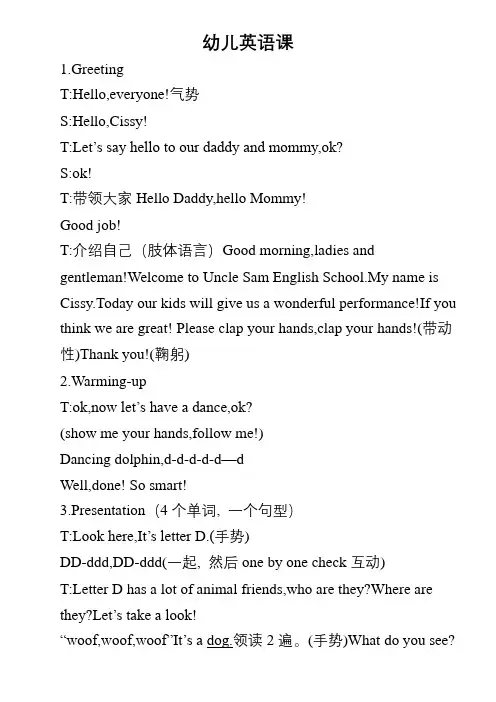
幼儿英语课1.GreetingT:Hello,everyone!气势S:Hello,Cissy!T:Let’s say hello to our daddy and mommy,ok?S:ok!T:带领大家Hello Daddy,hello Mommy!Good job!T:介绍自己(肢体语言)Good morning,ladies and gentleman!Welcome to Uncle Sam English School.My name is Cissy.Today our kids will give us a wonderful performance!If you think we are great! Please clap your hands,clap your hands!(带动性)Thank you!(鞠躬)2.Warming-upT:ok,now let’s have a dance,ok?(show me your hands,follow me!)Dancing dolphin,d-d-d-d-d—dWell,done! So smart!3.Presentation(4个单词, 一个句型)T:Look here,It’s letter D.(手势)DD-ddd,DD-ddd(一起, 然后one by one check互动)T:Letter D has a lot of animal friends,who are they?Where are they?Let’s take a look!“woof,woof,woof”It’s a dog.领读2遍。
(手势)What do you see?.se..dog..se..dog.Nex.friend, wher.ar.you?Ohh,it’.a__. What do you see ?I see the duck.Nex.friend,what’.tha.?It’..__.领读2遍。

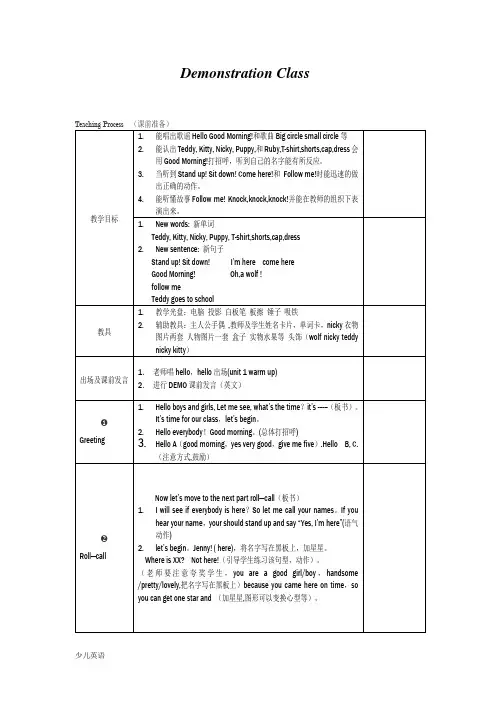
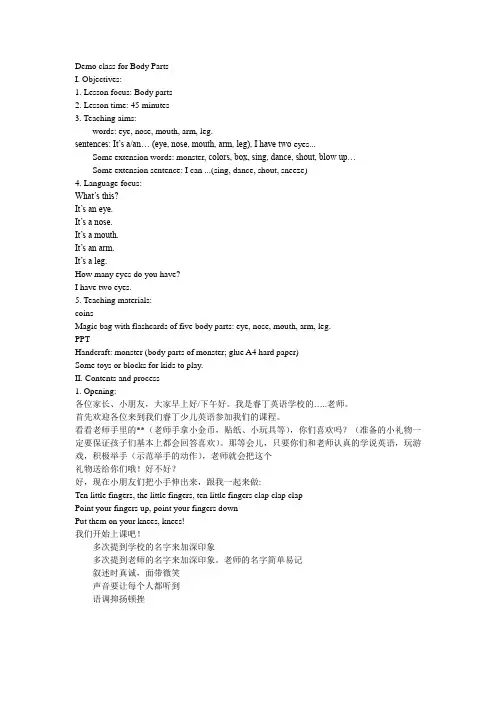

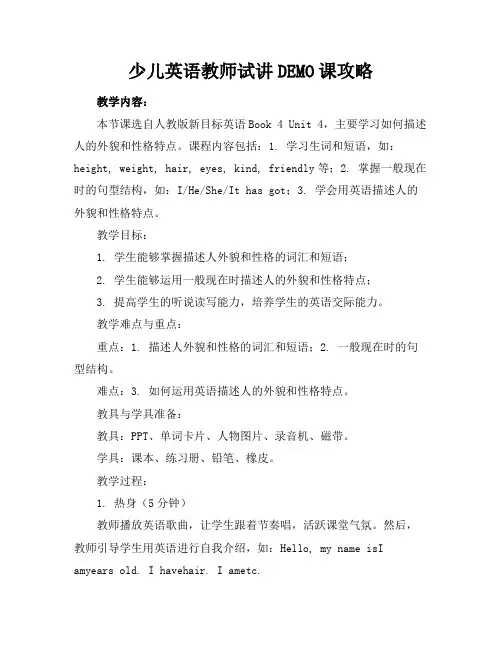
少儿英语教师试讲DEMO课攻略教学内容:本节课选自人教版新目标英语Book 4 Unit 4,主要学习如何描述人的外貌和性格特点。
课程内容包括:1. 学习生词和短语,如:height, weight, hair, eyes, kind, friendly等;2. 掌握一般现在时的句型结构,如:I/He/She/It has got;3. 学会用英语描述人的外貌和性格特点。
教学目标:1. 学生能够掌握描述人外貌和性格的词汇和短语;2. 学生能够运用一般现在时描述人的外貌和性格特点;3. 提高学生的听说读写能力,培养学生的英语交际能力。
教学难点与重点:重点:1. 描述人外貌和性格的词汇和短语;2. 一般现在时的句型结构。
难点:3. 如何运用英语描述人的外貌和性格特点。
教具与学具准备:教具:PPT、单词卡片、人物图片、录音机、磁带。
学具:课本、练习册、铅笔、橡皮。
教学过程:1. 热身(5分钟)教师播放英语歌曲,让学生跟着节奏唱,活跃课堂气氛。
然后,教师引导学生用英语进行自我介绍,如:Hello, my name isI amyears old. I havehair. I ametc.2. 引入(10分钟)教师向学生介绍本节课的主要内容:描述人的外貌和性格特点。
通过展示人物图片,让学生猜测人物的外貌和性格特点,引发学生对主题的兴趣。
3. 呈现(15分钟)教师通过PPT展示生词和短语,如:height, weight, hair, eyes, kind, friendly等。
引导学生跟读,解释词义,并进行相应的练习。
4. 操练(10分钟)教师组织学生进行小组活动,让学生用英语描述自己或同伴的外貌和性格特点。
鼓励学生大胆开口,提高口语表达能力。
5. 巩固(10分钟)教师出示人物图片,让学生用英语描述人物的外貌和性格特点。
然后,让学生听录音,跟读,巩固所学内容。
6. 作业布置(5分钟)教师布置作业:1. 抄写生词和短语;2. 用英语写一篇关于自己或同伴的外貌和性格特点的短文。
少儿英语示范课demo课【原创版】目录1.少儿英语示范课的重要性2.少儿英语示范课的内容3.少儿英语示范课的实际应用4.少儿英语示范课的未来发展正文随着全球化的不断深入,英语已经成为了世界范围内最重要的交流语言。
而对于我国的少年儿童来说,学习英语的重要性更是不言而喻。
在这个大背景下,少儿英语示范课应运而生,成为了孩子们学习英语的重要途径。
少儿英语示范课的重要性主要体现在以下几个方面。
首先,它可以帮助孩子们建立起学习英语的兴趣,让他们在愉悦的氛围中学习英语。
其次,它可以帮助孩子们掌握英语的基本语法和词汇,为他们今后的英语学习打下坚实的基础。
最后,通过少儿英语示范课的学习,孩子们可以提高自己的英语听说能力,更好地适应未来社会的需求。
少儿英语示范课的内容主要包括英语的基本语法、词汇和听说训练。
在语法方面,示范课通常会从简单的句子结构和时态入手,逐步引导孩子们掌握英语的基本语法规则。
在词汇方面,示范课通常会以主题的形式进行,如颜色、动物、家庭等,帮助孩子们记忆相关词汇。
在听说训练方面,示范课通常会通过情景对话、角色扮演等方式,让孩子们在实际应用中提高自己的英语听说能力。
少儿英语示范课的实际应用主要体现在课堂教学和家庭教育两个方面。
在课堂教学中,教师可以通过示范课的方式,引导孩子们积极参与英语学习,提高他们的学习兴趣和效果。
在家庭教育中,家长可以通过陪孩子观看少儿英语示范课的视频,帮助孩子巩固课堂所学,提高他们的英语听说能力。
随着科技的发展,少儿英语示范课的未来发展前景广阔。
一方面,随着网络的普及,少儿英语示范课可以以网络课程的形式存在,让孩子们随时随地进行学习。
另一方面,随着人工智能技术的发展,少儿英语示范课可以结合人工智能,如通过智能语音助手进行听说训练,通过虚拟现实技术进行情景对话等,让孩子们在更真实的环境中学习英语。
总的来说,少儿英语示范课对于孩子们的英语学习具有重要的作用。